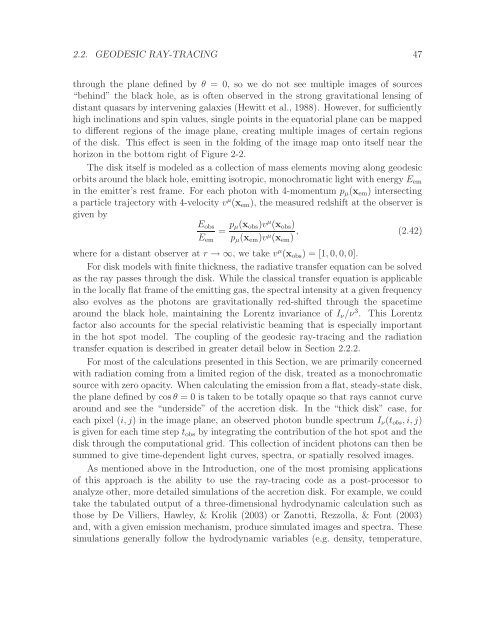Radiation Transport Around Kerr Black Holes Jeremy David ...
Radiation Transport Around Kerr Black Holes Jeremy David ...
Radiation Transport Around Kerr Black Holes Jeremy David ...
Create successful ePaper yourself
Turn your PDF publications into a flip-book with our unique Google optimized e-Paper software.
2.2. GEODESIC RAY-TRACING 47<br />
through the plane defined by θ = 0, so we do not see multiple images of sources<br />
“behind” the black hole, as is often observed in the strong gravitational lensing of<br />
distant quasars by intervening galaxies (Hewitt et al., 1988). However, for sufficiently<br />
high inclinations and spin values, single points in the equatorial plane can be mapped<br />
to different regions of the image plane, creating multiple images of certain regions<br />
of the disk. This effect is seen in the folding of the image map onto itself near the<br />
horizon in the bottom right of Figure 2-2.<br />
The disk itself is modeled as a collection of mass elements moving along geodesic<br />
orbits around the black hole, emitting isotropic, monochromatic light with energy E em<br />
in the emitter’s rest frame. For each photon with 4-momentum p µ (x em ) intersecting<br />
a particle trajectory with 4-velocity v µ (x em ), the measured redshift at the observer is<br />
given by<br />
E obs<br />
= p µ(x obs )v µ (x obs )<br />
E em p µ (x em )v µ (x em ) , (2.42)<br />
where for a distant observer at r → ∞, we take v µ (x obs ) = [1, 0, 0, 0].<br />
For disk models with finite thickness, the radiative transfer equation can be solved<br />
as the ray passes through the disk. While the classical transfer equation is applicable<br />
in the locally flat frame of the emitting gas, the spectral intensity at a given frequency<br />
also evolves as the photons are gravitationally red-shifted through the spacetime<br />
around the black hole, maintaining the Lorentz invariance of I ν /ν 3 . This Lorentz<br />
factor also accounts for the special relativistic beaming that is especially important<br />
in the hot spot model. The coupling of the geodesic ray-tracing and the radiation<br />
transfer equation is described in greater detail below in Section 2.2.2.<br />
For most of the calculations presented in this Section, we are primarily concerned<br />
with radiation coming from a limited region of the disk, treated as a monochromatic<br />
source with zero opacity. When calculating the emission from a flat, steady-state disk,<br />
the plane defined by cos θ = 0 is taken to be totally opaque so that rays cannot curve<br />
around and see the “underside” of the accretion disk. In the “thick disk” case, for<br />
each pixel (i, j) in the image plane, an observed photon bundle spectrum I ν (t obs , i, j)<br />
is given for each time step t obs by integrating the contribution of the hot spot and the<br />
disk through the computational grid. This collection of incident photons can then be<br />
summed to give time-dependent light curves, spectra, or spatially resolved images.<br />
As mentioned above in the Introduction, one of the most promising applications<br />
of this approach is the ability to use the ray-tracing code as a post-processor to<br />
analyze other, more detailed simulations of the accretion disk. For example, we could<br />
take the tabulated output of a three-dimensional hydrodynamic calculation such as<br />
those by De Villiers, Hawley, & Krolik (2003) or Zanotti, Rezzolla, & Font (2003)<br />
and, with a given emission mechanism, produce simulated images and spectra. These<br />
simulations generally follow the hydrodynamic variables (e.g. density, temperature,
















